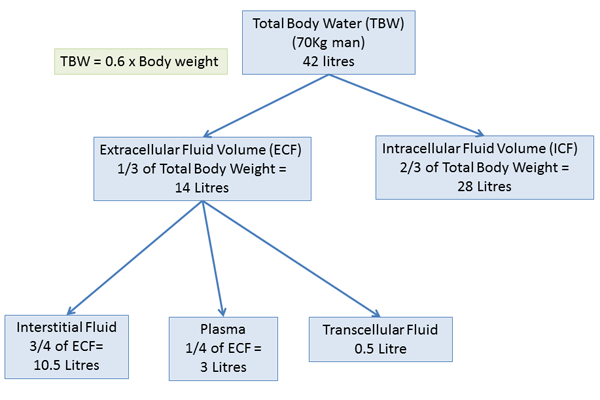Measurement Of Body Fluid Compartment Volumes
Intracellular fluid 33 231 litres.
Measurement of body fluid compartment volumes. Most of the water in the body is intracellular fluid. Body fluid compartments and measurement general physiology duration. A pie graph showing the proportion of total body fluid in each of the bodys fluid compartments. The tracers used are the azo dye known as evans blue or t1824 which binds avidly to albumin or radio iodine labelled serum albumin risa.
Extracellular fluid volume measurement. Unfortunately some bromine 82 also distributes into the cells. This volume is regulated by the movement of free water. Measurement of plasma volume requires a tracer which is mostly limited to this compartment and this is achieved by using a tracer which binds to albumin.
To measure the volume of any fluid compartment within the body you must inject or infuse a marker substance that will equilibrate diffuse freely to a uniform concentration throughout this compartment. The volume of the plasma is around 3 litres in an average person but the average blood volume is 4 6 litres. If you measure too soon all you will get is the volume of the functional extracellular fluid. At 60 years of age you if male only have 50 body water instead of 60.
As you age you dehydrate. Measurement of fluid volumes in the different body fluid compartmentsthe indicator dilution principle. It takes time for tracer to enter the slow compartments of bone and connective tissue. The ecf accounts for the other one third of the bodys.
The second largest volume is the interstitial fluid which surrounds cells that are not blood cells. The plasma volume is calculated by evans blue technique the proportion of plasma and hematocrit is by centrifugation. Thus bromine measurements of the ecf volume frequently over estimate the ecf volume. Measuring body fluid compartments.
Then make proportion calculation. The fluid compartment volume. Taken separately there is wide variation in the fat mineral and fluid composition of body tissues. The volume of a fluid compartment in the body can be measured by placing an indicator substance in the compartment allowing it to disperse evenly through out the compartments fluid and then analyzing the extent to which the substance becomes diluted.
To be a perfect marker a substance must also not be metabolised. Measurement of plasma volume requires a tracer which is mostly limited to this compartment and this is achieved by using a tracer which binds to albumin. Properties of the tracer and compartment measured blood volume versus plasma volume.



















